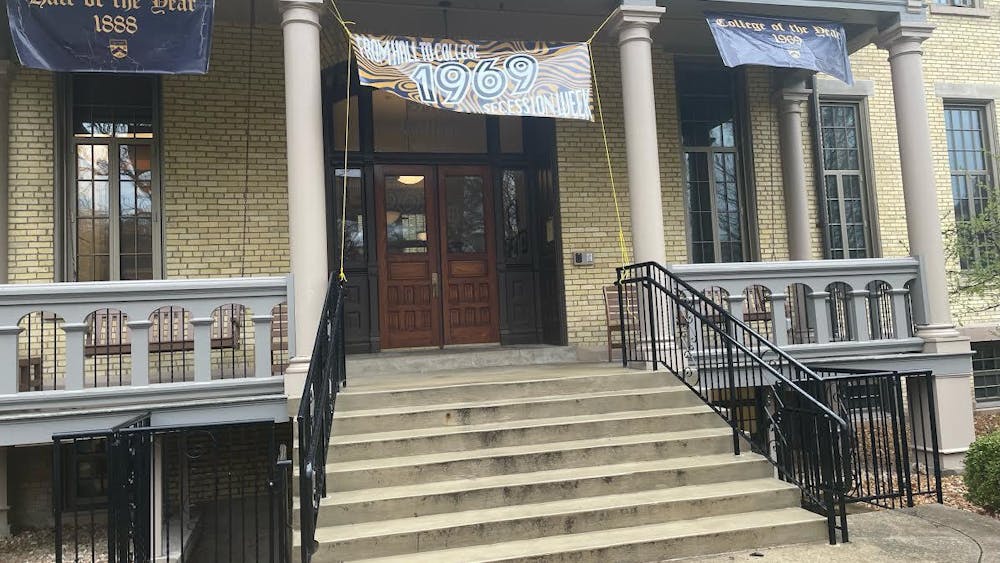Sebastián Mazzuca, assistant professor at Johns Hopkins, delivered a lecture on the relationship between state formation and economic failure in South America on Monday in the Hesburgh Center for International Studies.
In mainstream history, state formation in Latin America is essentially about fragmentation, Mazzuca said.
“If you compare two maps, compare the map of colonial Latin America to contemporary Latin America, there’s an obvious change in number, in size,” he said. “There were five political units in colonial Latin America, and there are 20-plus countries today.”
The income per capita in Latin American countries is a fifth of the income of advanced economies, Mazzuca said.
“The question is, ‘Why does it exist, why is it there?’” he said. “Of course, the gap began more than 200 years ago. It began small, but it began and remains.”
Intermediate maps provide a fuller story, Mezzuca said.
“If you look at intermediate maps, you will see that in the very first decades after independence, even in what today is Argentina, you have at least four distinct political units,” he said. “So in between these two things, you have a different trajectory, which is atomisation first and then reaggregation. It is not a history of fragmentation, it is a more complicated story — it’s not that complicated, but it’s more interesting and more complicated.”
Mezzuca said countries in South America that have the potential to become advanced economies with sustained growth but failed were “perverse combinations” of subnational regions.
“The second question, which has to do with state formation, is, ‘Why did state formation in South America result in the creation of economical dysfunctional national arenas?’” he said. “Although most state formation in early modern Europe were military conquests … [in South America] you also don’t see economic mergers, which is another path to state formation. It is neither a military conquest nor economic merger, but it is actually a process of coalition building.”
State formation from the 1840s through the 1860s led to the creation of countries as dysfunctional territorial matches, Mezzuca said, which then resulted in economic failures in these countries.
Examining “quasi takeoffs” in South American countries provide a shortcut to understanding 200 years of complicated economic history, Mezzuca said.
“The quasi takeoffs are the moment in which some countries were really likely to start sustained economic growth, or they initiated it and then reversed,” he said.
From 1817 to 1903, Argentina experienced a period of sustained economic growth, Mezzuca said.
“It went from 55, 60 percent of the income per capita of rich countries, and I mean France, the UK, England and Australia, to 98 percent the income of those countries,” he said. “It became an advanced country by 1908, but not only that — it stayed there for another twenty-two years and a half. … It stayed there, and then it reversed back in a sustained fashion until it’s back to 40 percent of the income of advanced countries.”
From 1950 to 1970, Brazil experienced a period of economic growth, Mezzuca said, and from 2002 to 2022 there has been another opportunity for economic growth.
“It is really too tell. We don’t know if anything’s going to happen. We are almost sure Chile is going to make it into the income bracket of the advanced economies,” he said. “It has been growing faster, by half a percent faster than advanced economies for 25 years already. That’s really a lot — it’s very hard to derail Chile from that.”
Mezzuca said the first emerging market in Latin America in the 1870s had many short-lived booms. Two regions had “winning tickets” for the commodity lottery and the potential to be growth engines for entire continent.
“The Paraiba Valley, is one, that’s in the Sao Paolo area in Brazil,” he said. “The main product there is coffee. Of course, coffee, you do not know for sure if it’s a winning ticket ticket … but Brazil, coffee production was so big — actually it was a quasi-monopoly — that it could create price-setting mechanisms.”
The Pampas in Argentina was another area that had a “winning ticket” in the commodity lottery, Mezzuca said, and experienced exceptional growth.
“There it was not coffee, it was wool, it’s wheat, it’s beef,” he said. “There was a string of booms, and they were sustained booms.”
Economists believe innovation and investment equal growth, Mezzuca said. There are fundamental answers, which include culture, geography and institutions, but have a serious flaw in that there is competition among the factors instead of integration and interaction.
“There’s nothing systematic. So that to me is the main limitation, so we’re trying to combine stuff a little bit, combine classes of economic causes,” he said.
The answer to the question of economic failure in South America is perverse combinations of subnational regions, Mezzuca said.
“The first reason why countries can be perverse combinations [is that] of course, national income level is an average of subnational income levels,” he said. “While this is sort of trivial, but it points to the fact that in Latin America income inequality is very bad in terms of social groups and classes, but there is a huge inequality across regions.”
There are also economic mechanisms at play, Mezzuca said, if there are countries that contain “backwards” and “dynamic” regions.
“The dynamic sector exports and then the exports from the dynamic sector produce an influx of hard currency donors that overvalues the exchange rate, and that overvaluation pushes the other regions into a complete lack of competitiveness — they cannot be competitive because of the exchange rate that’s given by the dynamic regions,” he said.
Mezzuca said political mechanisms are the key contributor to economic failure in South American countries.
“It’s a two-sided thing. One is the exploitation of the center by the periphery, so the surplus of the center can be transferred to the periphery at a high cost, in terms of sustainability,” he said. “So there’s an inefficient transfer of resources from the center to the periphery. … Second, not only the center gets weakened, but also, the periphery gets weakened in the long run.”
Mezzuca said another political geography was possible for South America, and said new evidence suggests that for a time, Argentina could be an “obvious yes,” after the creation of the Argentine Republic in 1861.
“A few months later, after what is considered to be the moment of unification, [the Spanish consul in Montevideo] wrote to his boss, wrote to the crown in Spain, to say that, ‘I foresee partition and secession within Argentine Confederation,’” he said.
Comparative history depicts Brazil as the strongest South American state in terms of post-independence secession risks, Mezzuca said, but even independent Brazil was contested.
Mezzuca said local division and national unification can actually help aggregate an entire country.
“Division within a subnational reason drives the two factions within that region to compete for allies, and maybe under some conditions that search for allies in subaggregating regions into a national arena,” he said.
There is a clear trade off as local factions search for external allies, Mezzuca said, and trade economic development for political power.













